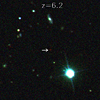SDSS 1030+0524
Chandra Finds Well-Established Black Holes In Distant Quasars
These three quasars, recently discovered at optical wavelengths by the Sloan Digital Sky Survey, are 13 billion light years from Earth, making them the most distant known quasars. The X-rays Chandra detected were emitted when the universe was only a billion years old, about 7 percent of the present age of the universe.
A surprising result was that the power output and other properties of these quasars are similar to less distant quasars. This indicates that the conditions around these quasars' central supermassive black holes must also be similar, contrary to some theoretical expectations. As astronomer Smita Mathur of Ohio State, who was involved in the research said, "Perhaps the most remarkable thing about them is that they are so absolutely unremarkable."
By various estimates, the supermassive black holes in these quasars weighed in at somewhere between one and 10 billion times the mass of the Sun. The implication is that the black holes put on a lot of weight soon after the galaxies formed.
|
||||||||||||||||||||||||||
|
||||||||||||||||||||||||||
|
||||||||||||||||||||||||||
X-ray images of three different quasars, discovered at optical wavelengths by the Sloan Digital Sky Survey (SDSS), are shown in a three-panel image with two images up top and one below them. At 13 billion light years from Earth, these are the most distant known quasars at the time of observation. The X-rays Chandra detected were emitted when the universe was only a billion years old, about 7 percent of the present age of the universe. In each of the three images, the brightest part of the quasar appears as a strong orange dot in the middle of a black background with a white arrow pointing to it. The upper left and bottom images have one and two additional softer orange background sources, respectively. The quasar objects' names are written in each image box, from top left to bottom: SDSS 0836+0054, SDSS 1030+0524 and SDSS 1306+0356.





